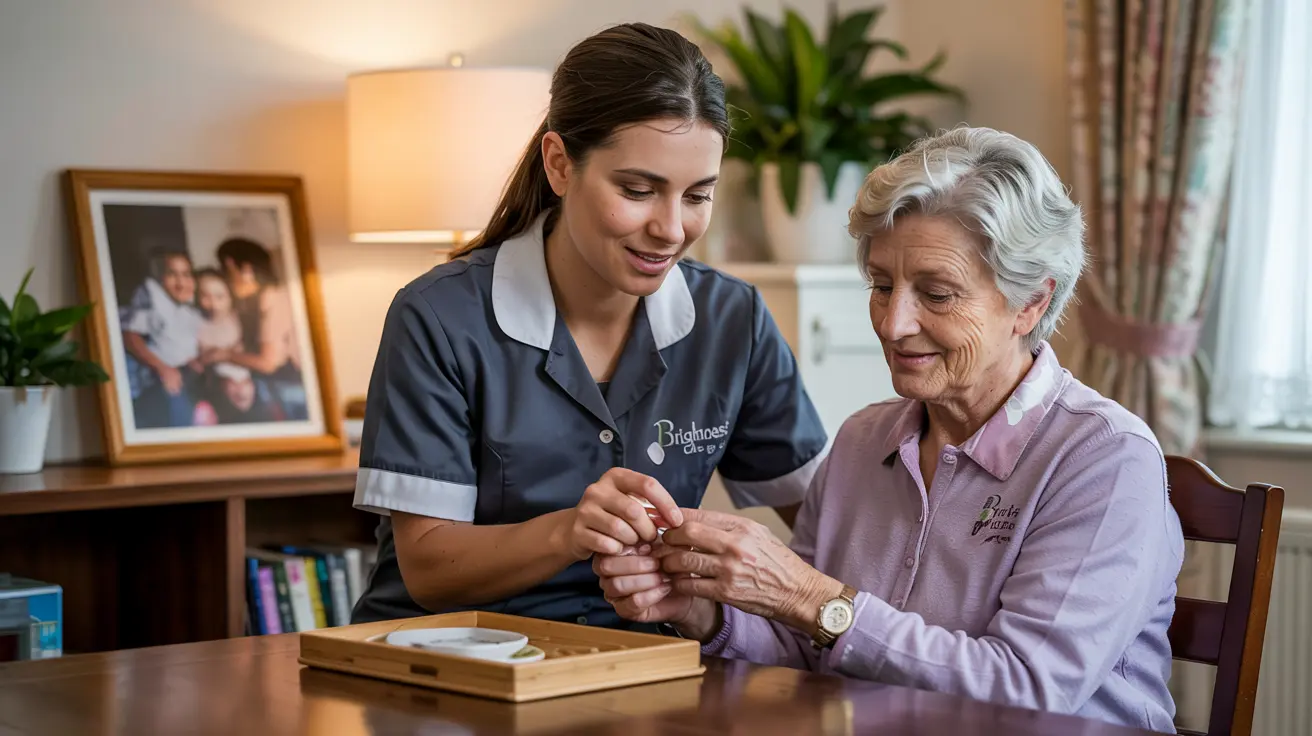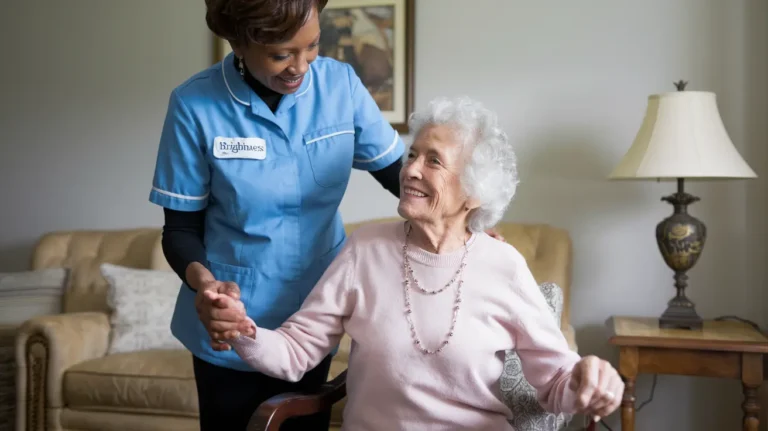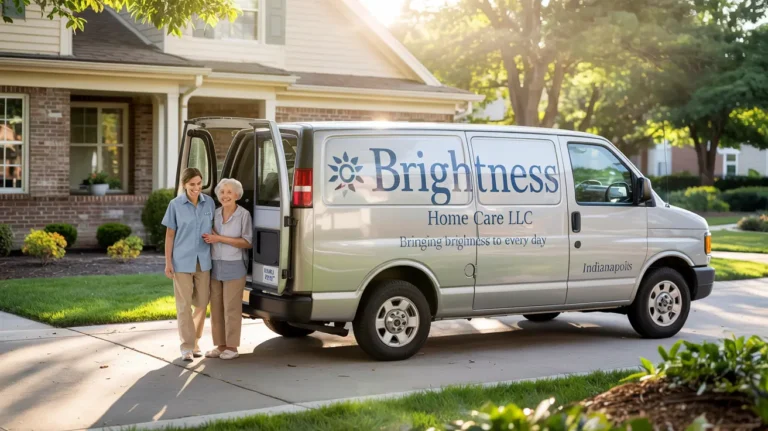In-Home Memory Care vs. Memory Care Facilities in Indianapolis: Which Is Right for Your Loved One?
Did you know that over 110,000 Indiana residents are currently living with Alzheimer’s disease? And that number is expected to grow by nearly 10% in the coming years! I remember when my own aunt was diagnosed with dementia, and our family faced what felt like an impossible decision – should we look into specialized facilities or try to keep her in the comfort of her own home?
Making care decisions for a loved one with memory issues is honestly one of the most gut-wrenching experiences a family can go through. You want the absolute best for them, but sometimes it’s hard to know exactly what “best” means in these situations.
When it comes to memory care in Indianapolis, families typically consider two main options: in-home memory care services or dedicated memory care facilities. Each has its own set of benefits and challenges that need to be weighed carefully against your loved one’s specific needs.
As someone who’s worked closely with families facing this decision, I’ve seen firsthand how important it is to understand all your options. Here in Indianapolis, Brightness Home Care LLC has been providing specialized in-home memory care services that allow seniors to receive professional care while remaining in familiar surroundings. But is that the right choice for everyone? Let’s dive into the details so you can make an informed decision.
Understanding Memory Care Needs for Seniors with Dementia
Memory conditions like dementia and Alzheimer’s aren’t static – they’re progressive journeys that change over time, sometimes gradually and sometimes with sudden shifts that catch families off guard. I’ve worked with hundreds of families over the years, and I can tell you that no two dementia journeys look exactly alike.
In the early stages, your loved one might just need occasional reminders or light supervision. Maybe they forget to take medications sometimes or leave the stove on once in a while. These moments can be scary, but they’re usually manageable with some family support and basic safety modifications. I remember one client who was doing pretty well living independently until she started getting lost on her daily walks around the neighborhood. That was the first real red flag for her family.
As the condition progresses, though, the challenges become more intense. Personal care activities like bathing, dressing, and toileting start requiring assistance. Behavior changes can emerge – sometimes including aggression, wandering, or severe confusion, especially during evening hours (we call this “sundowning”). Nights can become particularly challenging when someone with dementia reverses their sleep schedule or wakes up disoriented multiple times.
The tipping point for many families comes when safety concerns become overwhelming. When Dad started leaving the house at 3 AM in his pajamas or Mom couldn’t remember her own address anymore – these are the situations that often push families to seek professional help.
What makes memory care so different from regular elder care is the need for specialized approaches. Someone with dementia needs caregivers who understand the condition and know techniques for communication, redirection, and managing difficult behaviors. Regular reminders, consistent routines, and environments designed to reduce confusion all become critical.
One thing I’ve learned is that dignity preservation should be at the heart of all memory care. Just because someone can’t remember what they had for breakfast doesn’t mean they don’t deserve respect and autonomy in areas where they can still manage. Finding this balance is challenging but so important.
The emotional toll on family caregivers can be massive, too. I’ve seen adult children trying to work full-time jobs while caring for a parent with advanced dementia, and the burnout is real. Sometimes the best thing for everyone is bringing in professional memory care support – whether that’s in-home or in a facility setting.
Assessment is key in understanding where your loved one falls on this spectrum. A good geriatric assessment from a doctor specializing in memory disorders can provide valuable insights into current abilities and needs. Many families I’ve worked with find that getting this professional evaluation helps them make more confident decisions about the level of care needed.
What Is In-Home Memory Care in Indianapolis?
In-home memory care is exactly what it sounds like – bringing specialized memory care services right into your loved one’s home. But it’s so much more complex than just having someone drop by to help with meals or medications. Trust me, I’ve seen both exceptional and mediocre in-home care, and the difference is night and day.
When done right, in-home memory care creates a comprehensive support system tailored specifically to your loved one’s needs, routines, and environment. Here in Indianapolis, companies like Brightness Home Care LLC have developed specialized memory care programs that go well beyond basic homemaker services. I was seriously impressed when I first learned about their approach – they really get the unique challenges of memory conditions.
The scope of services can be pretty broad. On the practical side, there’s medication management (which is HUGE – medication errors can be dangerous and are common among people with memory issues), personal care assistance with bathing and dressing, meal preparation focusing on good nutrition, and help with light housekeeping to maintain a safe environment. But good providers take it much further with cognitive stimulation activities, safety monitoring, and companionship that helps prevent the isolation that can accelerate cognitive decline.
What sets Brightness Home Care apart in Indianapolis is their specialized training program for memory care providers. Their caregivers receive extensive education in dementia communication techniques, redirection strategies for challenging behaviors, and understanding the progression of different types of dementia. This isn’t knowledge that comes naturally – it requires dedicated training and experience.
The beauty of in-home care is the continuity. Rather than having multiple different staff members as you might in a facility, in-home care often means working with the same caregiver or small team who really get to know your loved one’s preferences and quirks. I remember one client who would only take her medication if it was presented with a specific routine and wording – her in-home caregiver knew exactly how to make this happen, while new people would struggle.
The biggest advantage? Environment familiarity. I cannot overstate how important this is for someone with memory impairment. Keeping someone in the space where they’ve lived for years, surrounded by familiar objects, photos, and routines, can significantly reduce confusion and anxiety. Your loved one already knows where the bathroom is in their own home – they don’t have to relearn this as they would in a new facility. This familiarity often means fewer behavioral issues and a higher quality of life.
Care can be scaled from just a few hours of help per week to round-the-clock support, depending on needs and budget. Some families start with afternoon coverage when sundowning behaviors typically emerge, while others need overnight support to manage wandering risks or disrupted sleep patterns.
What Are Memory Care Facilities in Indianapolis?
Memory care facilities in Indianapolis range from cozy residential homes with just 8-10 residents to larger institutional settings that might house 50 or more people with memory conditions. I’ve toured dozens of these places over the years, and let me tell you – they can differ dramatically in atmosphere, approach, and quality of care.
At their core, these facilities are designed specifically for people with Alzheimer’s, dementia, and other memory disorders. Unlike regular assisted living facilities, true memory care residences have enhanced security features – coded door locks, alarmed exits, enclosed outdoor spaces – all designed to prevent the wandering that can be so dangerous for someone with memory impairment. I still remember the relief on one daughter’s face when she realized her mom couldn’t just walk out onto a busy street as she had been doing at home.
The physical environment in good memory care facilities is intentionally designed to reduce confusion. You’ll typically see clear wayfinding cues, color-coding to help residents identify their rooms, memory boxes outside doors with personal mementos, and simplified floor plans. Some of the newer facilities have even incorporated circular hallway designs to eliminate dead ends that can cause frustration for residents who pace or wander.
Staffing is where memory care facilities really differ from in-home care. Most facilities maintain higher staff-to-resident ratios than regular nursing homes, typically around 1:5 to 1:8 depending on the time of day. Staff members should receive specialized training in dementia care techniques. The best facilities have dedicated memory care directors with advanced certifications in dementia care who oversee the programming and train other staff members.
Daily life in a memory care facility revolves around structured routines – consistent meal times, regular activities, and predictable care schedules. This structure helps residents feel more secure, though it’s definitely less flexible than care at home. Activities are designed specifically for people with cognitive impairment – music therapy (which can be amazingly effective!), simplified art projects, sensory stimulation, and reminiscence activities are common.
One significant benefit of facility care is the social dimension. Even with cognitive impairment, many people still benefit from being around others. I’ve watched residents who barely communicate verbally light up during group music sessions or pet therapy. This social stimulation is harder to replicate in a home setting, especially if your loved one lives alone.
Medical oversight tends to be more comprehensive in facilities as well. Many have visiting physicians, regular nurse assessments, and systems for monitoring changes in condition. Medication management is handled entirely by staff, eliminating the risk of missed doses or confusion about pills that often happens at home.
That said, facilities do have their limitations. Care isn’t as personalized as one-on-one home care. Staff turnover can be high in some facilities, leading to inconsistent care. And the institutional nature of some settings – shared dining rooms, scheduled shower times, less privacy – can be difficult for some seniors to adjust to, especially those who have lived independently for decades.
Cost Comparison: In-Home vs. Facility Memory Care
Let’s talk money – because caring for someone with dementia isn’t cheap either way, and I’ve seen too many families caught off guard by the costs involved. Being realistic about finances from the beginning can save a lot of heartache down the road.
For in-home memory care in Indianapolis, you’re typically looking at hourly rates ranging from $25-35 per hour for basic care, with specialized memory care sometimes commanding higher rates. Do the math, and you’ll see how quickly this adds up. Even just 4 hours of daily care runs about $3,000-4,200 monthly. For comprehensive round-the-clock care at home (which many advanced dementia patients eventually need), costs can easily exceed $15,000 per month. Yikes, I know!
Brightness Home Care LLC offers competitive rates in the Indianapolis market, and they’re upfront about their pricing structure – something I always appreciate after seeing some providers hit families with surprise charges. They also offer different levels of care packages depending on needs, which can help make the cost more manageable in earlier stages.
On the facility side, dedicated memory care residences in Indianapolis generally run between $5,000-8,000 per month, with some high-end places exceeding $10,000. This is significantly more than standard assisted living, reflecting the specialized care and enhanced security features. This cost typically covers room and board, basic care assistance, activities, and general supervision – though there may be additional charges for specific medical needs or higher levels of personal care assistance.
What complicates the comparison is that in-home care can sometimes be combined with family caregiving to reduce costs, while facility care is usually all-or-nothing. I’ve worked with families who provide morning and evening care themselves, bringing in professional caregivers just for daytime hours when family members are at work.
When it comes to paying for either option, the news isn’t great. Medicare doesn’t cover long-term memory care in either setting, which surprises many families. Traditional health insurance doesn’t cover it either. Medicare might cover short-term skilled nursing needs after a hospitalization, but not the ongoing supervisory care that dementia requires.
Some resources that can help: Long-term care insurance (if your loved one purchased it years ago – it’s too late once diagnosis occurs), Veterans benefits for those who qualify, and Indiana’s Aged & Disabled Medicaid Waiver program, which can cover some in-home services for those who meet income and asset requirements. For facility care, eventually spending down assets to qualify for Medicaid is a common reality, though the memory care options under Medicaid may be more limited.
Hidden costs exist in both scenarios. For home care, consider home modifications for safety, medical equipment not covered by insurance, and the potential lost income if family members reduce work hours to provide supplemental care. For facilities, there are often community fees (one-time entrance fees averaging $2,000-5,000), level of care increases as needs change, and additional charges for services like incontinence supplies or specialized treatments.
Long-term financial planning becomes crucial. The average person with Alzheimer’s lives 4-8 years after diagnosis, but some live 20+ years. That extended timeline means even substantial savings can be depleted. I strongly recommend consulting with an elder law attorney who understands how to protect some assets while planning for care needs – I’ve seen this save families enormous stress and hardship down the road.
Pros and Cons of In-Home Memory Care
After helping countless families navigate memory care decisions, I’ve developed a pretty clear picture of where in-home care shines and where it struggles. Let’s get real about both sides of this option.
The biggest advantage – and I mean HUGE advantage – is maintaining the comfort and familiarity of home. I cannot overstate how beneficial this familiarity can be for someone with memory impairment. Your loved one already knows the layout of their bathroom, which drawer holds their socks, and where to find their favorite chair. These environmental cues help maintain independence longer and reduce anxiety. I witnessed one gentleman who was completely disoriented in a facility setting during a respite stay, but functioned remarkably well back in his own home environment.
The personalized attention is another major plus. With in-home care, especially through quality providers like Brightness Home Care LLC, your loved one gets one-on-one attention from caregivers who can truly focus on their specific needs and preferences. There’s no competing with 15 other residents for assistance or attention. Care can be provided at your loved one’s pace rather than on an institutional schedule.
Family involvement is naturally much easier with in-home care too. You can drop by anytime, participate in care as much as you want, and maintain family routines and traditions. I still remember one family who continued their Sunday dinner tradition for years, with the caregiver helping their mom participate in simple food preparation tasks she could still manage. These moments become precious memories.
Flexibility is another advantage – care schedules can be adjusted as needs change, and approaches can be customized completely to your loved one’s preferences and quirks. If Mom always took her bath in the evening for 80 years, she can continue that routine rather than adjusting to a facility’s morning shower schedule.
But in-home care isn’t perfect, and I’d be doing you a disservice if I didn’t share the challenges too. The biggest limitation is often the physical home environment itself. Many Indianapolis homes, especially older ones, have stairs, narrow doorways, or bathrooms that aren’t easily accessible for someone with mobility challenges (which often accompany advanced dementia). Modifications can help but are sometimes costly or impractical.
Safety concerns can become significant as dementia progresses, particularly during hours when professional caregivers aren’t present. Without 24/7 coverage, risks of wandering, falls, or kitchen accidents exist. I’ve had more than one client who got up in the middle of the night and turned on the stove, creating dangerous situations.
Caregiver consistency can sometimes be challenging too, though Brightness Home Care works hard to maintain stable assignments. Still, illness, turnover, or scheduling conflicts can sometimes mean new faces, which can be disorienting for someone with memory issues.
Social isolation is another potential downside of remaining at home, especially if your loved one previously enjoyed an active social life. As driving and independent transportation become impossible, the world can shrink dramatically. While caregivers provide companionship, it’s not the same as having peers to interact with regularly.
Cost efficiency becomes questionable as care needs increase. While in-home care is often more affordable for part-time needs, once you require round-the-clock coverage, facility care often becomes the more economical option. I’ve helped many families make this transition when they realized they were spending significantly more for 24/7 home care than a quality memory care facility would cost.
Brightness Home Care LLC addresses many of these concerns through their comprehensive approach. They offer home safety evaluations to identify and address potential hazards. Their specialized memory care training helps caregivers manage challenging behaviors effectively at home. And they work closely with families to create balanced care plans that maximize coverage during highest-risk times while managing costs.
Pros and Cons of Memory Care Facilities
Memory care facilities offer a completely different approach than in-home care, with their own distinct advantages and limitations. After touring dozens of facilities around Indianapolis with families, I’ve seen both the impressive benefits and the potential drawbacks.
The most significant advantage of facility care is the comprehensive 24/7 professional supervision. This constant oversight virtually eliminates concerns about wandering, unsafe cooking attempts, medication errors, or falls going undetected. For families who’ve been losing sleep worrying about what might happen during unattended hours, this peace of mind is invaluable. I remember one exhausted daughter telling me she finally slept through the night for the first time in two years after her father moved into memory care.
The specialized environmental design of good memory care facilities is purpose-built for safety and orientation. Secured entries and exits, emergency response systems, grab bars in bathrooms, and clear wayfinding cues create a setting where residents can maintain maximum independence with minimum risk. Some facilities even use technology like bed alarms, motion sensors, and wearable location devices to enhance safety while preserving dignity.
Medical oversight tends to be more robust in facility settings too. Most have regular nurse assessments, vitals monitoring, weight tracking, and systems for identifying subtle health changes early. Many have visiting physicians or nurse practitioners who see residents on-site, eliminating stressful medical appointments. The coordination of care between different providers happens more seamlessly when everything’s under one roof.
The social dimension of facility life can be tremendously beneficial for many seniors with memory issues. Even with cognitive impairment, many people still respond positively to appropriate social engagement. Structured activities specifically designed for those with memory impairment – like music therapy, simplified art projects, gentle exercise classes, pet therapy, and reminiscence groups – provide cognitive stimulation in a supportive environment. I’ve watched residents who rarely spoke suddenly become animated during a familiar song or when petting a therapy dog.
For family members, facility care can mean a return to being just family again, rather than being caught in the exhausting dual role of loved one and caregiver. This role restoration often improves relationship quality during visits, as stress levels decrease and interactions can focus on connection rather than care tasks.
However, facility care does come with significant drawbacks too. The institutional nature of even the homiest facilities means some level of regimentation is inevitable. Meals, activities, and care routines happen on the facility’s schedule, not the resident’s lifelong personal rhythms. Preferences must sometimes give way to the needs of the community.
The adjustment period can be extremely difficult for some seniors. Moving is disorienting for anyone, but for someone with memory impairment, the change can trigger significant anxiety, confusion, and behavioral issues. I’ve seen new residents who became much more agitated or withdrawn during their first few weeks – though most do eventually adjust with time and consistent support.
Privacy is another consideration. Most residents share common spaces for dining and activities. Some facilities offer only shared rooms, though private rooms are becoming more common (for a higher price). For someone who has lived independently for decades, this reduction in personal space can be challenging.
Care, while professional, simply cannot be as personalized as one-on-one home care. Staff members are responsible for multiple residents simultaneously, meaning your loved one might sometimes wait for assistance or receive more generic approaches to care. Staff turnover in the industry can also mean inconsistency in caregivers, which can be confusing for residents who thrive on familiarity.
The physical distance from family can also impact visit frequency. Despite best intentions, many families find they visit less often than they anticipated once their loved one moves to a facility, especially if it’s not conveniently located near family members’ homes or workplaces.
And of course, the cost remains significant, often requiring substantial savings or asset spend-down, eventually leading to Medicaid for many families once resources are depleted.
How to Assess Which Option Is Right for Your Loved One
Making this decision requires honest evaluation of multiple factors – there’s no one-size-fits-all answer, and I’ve seen families struggle when they try to force a solution that doesn’t truly fit their situation. Let me walk you through a framework I’ve developed after helping hundreds of families through this process.
Start with a clear-eyed assessment of your loved one’s current condition – not where they were six months ago or where you fear they might be in the future. What specific care needs do they have right now? Can they manage personal care independently? Are they safely taking medications? Can they prepare simple meals? Are they oriented to time and place? Can they communicate needs clearly? A good geriatric assessment from a physician specializing in memory disorders can provide valuable insights here.
Safety considerations should be paramount in your decision-making process. I’ve seen too many families delay necessary care changes because of emotional attachments to a home, only to face a crisis when a serious fall or wandering incident occurs. Evaluate the home environment critically – are there stairs that present fall risks? Does the bathroom have safety features? Is the kitchen safe for someone with cognitive impairment? Is the neighborhood secure for someone who might wander? I remember one client whose otherwise ideal home had a front door that opened directly onto a busy street – a single moment of confusion could have been tragic.
Next, honestly assess your available support system. Do family members live nearby? How much hands-on care can they realistically provide on an ongoing basis? Be brutally honest here – good intentions often collide with the realities of job demands, childcare responsibilities, and caregiver burnout. I’ve seen too many adult children promise more involvement than they could sustain, leading to gaps in care.
Financial resources must be realistically evaluated as well. What can your loved one afford long-term? Remember that dementia care often extends for years. If assets are limited, how will care be funded once savings are depleted? Meeting with a financial advisor or elder law attorney who specializes in long-term care planning can provide valuable guidance on maximizing available resources.
When evaluating specific providers – whether home care agencies like Brightness Home Care LLC or memory care facilities – ask targeted questions about their dementia expertise:
- What specific dementia training do caregivers receive?
- How do they handle challenging behaviors?
- What’s their approach to promoting independence while ensuring safety?
- How do they handle communication difficulties?
- What’s their staff turnover rate? (Lower is generally better for consistency)
- How do they tailor care to individual preferences and histories?
Ask for references from families in similar situations, and if considering a facility, visit multiple times at different hours to get a complete picture. Watch how staff interacts with current residents – are they patient, respectful, and attentive?
Consider your loved one’s personality and lifelong preferences too. Were they always social, enjoying group activities and community settings? Or were they more private, preferring quiet and familiar surroundings? While dementia changes many things, core personality often remains, and honoring these traits can improve quality of life.
I also recommend creating a decision matrix – list the pros and cons of each option specifically for your situation, rather than generally. Weight the factors most important to your loved one and family. Sometimes seeing everything laid out visually helps clarify which direction to take.
Remember that there’s rarely a perfect solution – each option involves some compromise. The goal isn’t perfection but finding the best possible match between your loved one’s needs, preferences, available resources, and family capabilities. And remember – Brightness Home Care LLC offers free consultations to help Indianapolis families think through these complex decisions, even if you’re not certain in-home care is the right choice.
Transitioning Between Care Options as Needs Change
One critical truth about memory care that I learned early in my career: today’s right answer may not be tomorrow’s right answer. Dementia is progressive, and care needs evolve, sometimes gradually and sometimes suddenly following health events or significant behavioral changes. Planning for transitions rather than seeing your initial choice as permanent can save tremendous stress down the road.
The signs that care needs are evolving can be subtle at first – increased confusion in the evening, more difficulty with sequencing tasks like dressing or bathing, changes in sleep patterns, or increased anxiety. More obvious signs include unsafe wandering, significant weight loss, frequent falls, or the inability to recognize familiar people. Physical health complications like urinary tract infections, pneumonia, or stroke can accelerate cognitive decline, sometimes dramatically.
In my experience, the transition from independent living to some in-home support is usually the easiest step. Starting with just a few hours of professional help through Brightness Home Care LLC can supplement family caregiving and introduce the concept of accepting help gradually. I’ve found that beginning with less intensive services – perhaps companionship and light housekeeping – builds trust before adding more personal care services as needs increase.
The hardest transition is typically from in-home care to facility care, especially if the person with dementia has adamantly expressed wishes to remain home. Making this decision often involves difficult family conversations and sometimes requires guidance from healthcare providers to help everyone accept when home is no longer the safest option.
To make transitions smoother, I recommend several strategies that have worked for families I’ve supported:
Involve your loved one in decisions to the extent possible, especially in earlier stages. Using “we” language rather than “you” language helps – “We need some help with the house” rather than “You need a caregiver.”
Introduce changes incrementally when possible. For in-home care, start with shorter visits and consistent caregivers before expanding hours. When transitioning to a facility, consider short respite stays to introduce the environment before permanent moves.
Maintain familiar routines, objects, and photographs during transitions. These continuity elements provide essential anchors during change. When one client moved to memory care, her daughter created a memory box with family photos and small meaningful items that helped make her new space feel connected to her history.
Frame changes positively but honestly. Rather than focusing on deficits (“You can’t live alone anymore”), emphasize benefits (“This will give you more social activities” or “The dining room means no more cooking worries”).
Work with providers like Brightness Home Care LLC that understand transitional care. Their experience helping families navigate these changes is invaluable. They can often provide increasing levels of home care while also helping families recognize when facility care might become necessary.
Timing transitions thoughtfully matters too. When possible, make moves earlier in the day rather than in the evening when confusion often increases. Avoid major holidays or significant family dates that might increase emotional stress.
During facility transitions, family presence in the first few days is crucial for reassurance. Some facilities even offer “transitional packages” where staff provide extra support and attention during the adjustment period.
If the transition is to a facility, personalize the new living space before move-in day with familiar bedding, photographs, and meaningful items. Some families create memory books with simple stories and pictures explaining the new living arrangement that staff can review with residents who repeatedly question the change.
Medical professionals can be valuable allies during these transitions. Sometimes having a doctor explain the need for care changes carries more weight than family opinions. Geriatric care managers can also help coordinate complex transitions and mediate family disagreements about timing.
Remember that adjustment periods are normal. The first few weeks after any care transition are rarely smooth, but most people do adapt with consistent support and patience. I’ve watched residents who were initially very resistant to facility care eventually thrive in their new environments, sometimes even refusing to leave for family outings because they didn’t want to miss activities with their new friends!
Conclusion
Navigating memory care decisions for a loved one in Indianapolis involves balancing complex emotional, practical, and financial considerations. Whether you choose in-home memory care through a provider like Brightness Home Care LLC or opt for a dedicated memory care facility, the most important factor is finding an option that maximizes quality of life while ensuring safety and dignity.
Throughout this article, we’ve explored the distinct differences between these care models – from the personalization and familiarity advantages of in-home care to the round-the-clock supervision and social benefits of facility settings. We’ve examined costs, evaluated pros and cons, and discussed strategies for assessing which option might best fit your family’s unique situation.
What’s most important to remember is that there’s no one “right” answer that works for everyone. Each family’s journey through memory care is as unique as the individual experiencing cognitive changes. What works beautifully for one person might be completely wrong for another, even with similar cognitive conditions.
I encourage you to prioritize your loved one’s specific needs, preferences, and personality when making these decisions. Consider not just their care requirements but also what will provide them with comfort, meaning, and moments of joy despite their cognitive challenges. Remember that maintaining dignity and supporting independence wherever possible should remain central goals in any care setting.
For Indianapolis families exploring in-home memory care options, Brightness Home Care LLC offers specialized memory care services delivered by trained professionals who understand the unique challenges of dementia and Alzheimer’s care. Their personalized approach and flexibility can make aging in place possible for many seniors with memory impairments. I’d encourage you to reach out for a free consultation to discuss whether their services might be the right fit for your loved one’s needs.
Whatever path you choose, remember that seeking support for yourself is just as important as finding the right care for your loved one. Caregiver support groups, counseling resources, and respite care can help sustain you through the challenges of the dementia journey. You don’t have to navigate these complex decisions alone.
Have you had experience with either in-home memory care or memory care facilities? What factors ultimately influenced your family’s decision? Sharing our stories helps build community understanding and supports others facing similar choices. Feel free to reach out to Brightness Home Care LLC at their Indianapolis location on West 38th Street to learn more about memory care options or to schedule a personalized consultation.







